
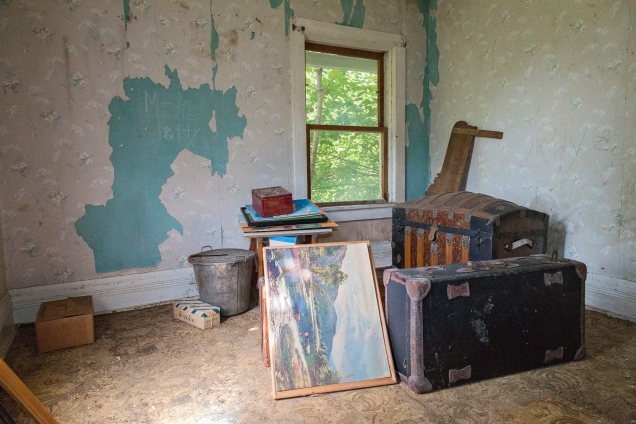










After spending years actively working to fight the tuberculosis epidemic, Dr. Henry Longstreet Taylor found himself frustrated with the slow pace of progress in his home state of Minnesota and decided to take matters into his own hands. In 1905, he utilized his own money to open a private institution on the outskirts of Pine City. It would inherit its name from the lake whose shores would border the property.

Spanning 35 acres, Pokegama Sanatorium would privately cater to a limited 36 patients. With a price of $30 to $50 a week, it was a staggering amount when compared to the county sanatoriums that rarely charged the maximum $7. With this price tag though, came a long list of luxurious amenities never seen in the overcrowded and understaffed county facilities.

The original 15 open-air cottages were comfortably warm with steam heat and woolen blankets, private bedrooms, and bathrooms that only had to be shared between two or three people. A private farm catering only to the sanatorium provided high quality food and the reception hospital added in the early 1920’s would have many modern amenities including elevators, a long-distance telephone system, and a high class surgical suite.


With ground being gained in the fight against tuberculosis and World War II creating a shortage of both supplies and staff, Pokegama would officially close its doors in 1944. Soon after shutting its doors, Pokegama was sold to a group called the Redemptorist Fathers, who intended to use it as a school for priests.

The site would again exchange hands and under the name “Pine Manor” it would function as a chemical dependency center. Compared with its Sanatorium predecessor, Pine Manor provided a relatively cheap treatment cost of roughly $2,000 compared to other privately owned centers in the state that charged anywhere from $4,000 to $7,000. Even with this advantage, Pine Manor would only last until 1986 when financial troubles would cause it to close its doors for one last time.

All that remains of the once sprawling estate is a shell of the once grand brick reception hall. Covered in graffiti and filled with the debris of old furniture and nights of partying, the hospital is certainly in its final stages of life. The peeling paint in the common asylum colors and walls covered in large windows still maintain a beautiful quality though.


After more than 20 years spent in empty and lonely solitude, how many more years does this forgotten sanatorium have left? Will it live to see another 20 years or does it have a limited amount of time left on the its clock?

One look at this house and you know it is something you don’t come across everyday. An utter lack of modern amenities, including electricity,running water or any trace of modern appliances testify to the age of this house. The only remaining access to the upper floors, a rusting ladder attached to the outside of the house, only adds to the strange quality of this house.

Even without the modern amenities that have come to characterize our idea of a house, there are numerous personal effects in each of the two first floor rooms. Debris litters the floor and hides the wood plank floor. A bookcase filled with dust covered bottles, an old fashioned desk with a painted dollhouse, and a partially collapsed dining room table all support the fact that this was indeed once a home to someone.
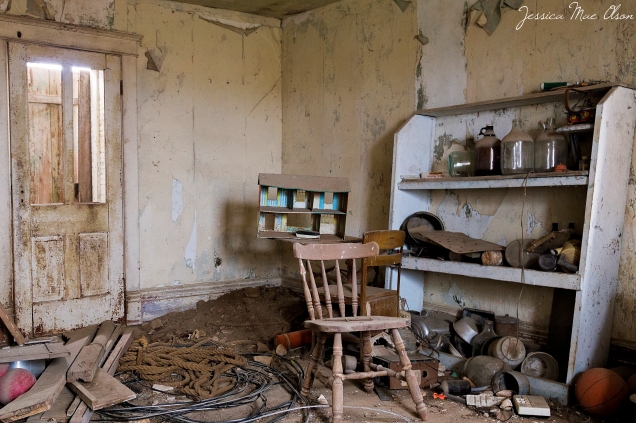
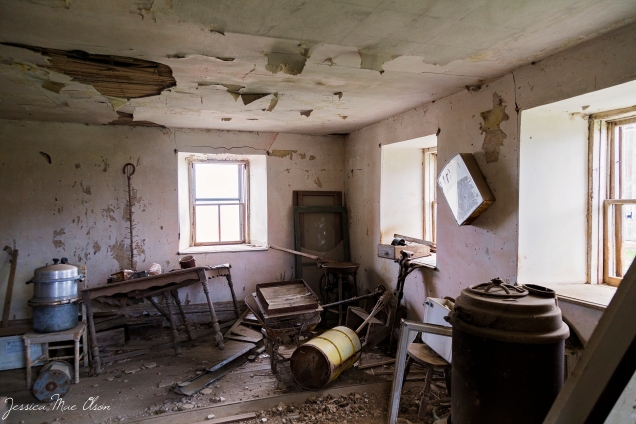
This house raises so many questions that have no answers. When was this house originally build and how long has it been sitting alone in rural Iowa?
Since February of 1989, this little farmhouse nestled in the heart of Wisconsin has been left in complete solitude to crumble and decay away. Without a single town in miles and few neighbors in sight, the farmhouse has truly managed to remain a time capsule of belongings and memories.

A house with so much visible history makes it hard to understand how so many personal artifacts can be left to nothing more than the cold hands of time. Is it possible to love something so much, we would rather see it rot than belong to someone else? Or do we simply see so much value in the things we love that we forget how meaningless they can be when left in the hands of a stranger.



On the other side, maybe I am being too romantic. While I like to think of love and laughter once filling these walls, I know that some places deserve nothing more than to be forgotten and left to rot. Not every piece of the past deserves to be remembered in the future. There are some parts of my own life that I have pushed into the dark recesses of my mind, hoping they will slowly rot away until they are nothing more than a dark whisper.



We will probably never know what this house truly was or what it meant to the people that once inhabited it, but it doesn’t really matter anyway. The fact is, it is there. Whether it left a beautiful or dark mark on the world, it has simply refused to be forgotten by a world that is trying to fade it away.
Maybe it is the fact that it has felt like a long winter, more so emotionally than anything, but it has been so difficult to find the motivation to go out and take pictures. I keep looking at my camera sitting in the corner and I swear I can see it collecting dust. There is no doubt that photography is my saving grace when depression is creeping at my door. Unfortunately though, they have yet to invent a camera that also pulls you away from your comfy couch and warm blanket.
This last weekend, I finally found a friend nearby that motivated me to go on an adventure in neighboring Wisconsin. Initially it seemed like a wonderful idea, especially considering the lack of snow and fairly reasonable winter temperatures. What we didn’t know is that we would be wading through knee deep snow for the entire day! I guess it wouldn’t be a true adventure without a few things failing to go according to plan right?

Our first find of the day turned out to be a gorgeous shell of a house. Nestled on the intersection of a fairly rural road, it was buried in a mess of trees and what I am certain is a lot of incredibly tall, tick infested grass.

One of the more interesting aspects of this house is the complete removal of all the original woodwork. Is it possible that someone cared enough to preserve each piece of trim and flooring, or was it left to rot and eventually stolen after years of decay? Certainly only one of dozens of mysteries lying within this charming farmhouses past.

It is also hard to deny the beauty in peeling wallpaper. I have yet to come across a room like this without it stopping me in my tracks. Something about it is so devastating, yet it almost provides a special glimpse into the secrets of a house. Like peeling back the layers of the houses life, you are slowly being allowed to see into the depth of its soul.

Maybe this is what makes these houses so beautiful to only certain people. Maybe you have to be damaged in some way to see the beauty behind something so decayed and to some, useless.
The San Haven State Hospital, originally known as the North Dakota Tuberculosis Sanitarium was opened to the public in November of 1912. Located in the Turtle Mountains of Rolette County, it was thought that the higher altitude and drier atmosphere would be favorable to patients with tuberculosis.
In the 1950’s, after antibiotics brought some control over the tuberculosis epidemic, the hospital remodeled, expanded, and ultimately opened its doors to the developmentally disabled and elderly. As with many state hospitals, rumors and questions regarding the treatment of it’s patients began to circulate and the hospital would eventually close in December of 1987 after a lengthy lawsuit.

Image Courtesy of North Dakota Newspaper Association
This once elaborate and expansive hospital now sits in ruins; only a ghost of it’s former self. A popular attraction for teenagers, there are an abundance of rumors regarding the presence of paranormal phenomenon, which only adds to the mystery and appeal. Even if this isn’t true, it is impossible to stand on the expansive and overgrown property and not feel emotional in some regard.


Standing in a building that looks almost post-apocalyptic, you can’t help but imagine the hundreds of people that walked those long halls. How different it must have been to see with the windows unbroken, the doors still attached to their hinges, and fresh paint covering the walls. I will let the pictures do the talking this time; all you have to do is listen.













During another one of my binges scanning google maps, I came across a promising looking little town in northern Minnesota. With a population barely reaching 144, there is nothing left of this little town but a few blocks of houses, a couple small town amenities and a large three story building at the very edge of town.
On a cold February day, we were greeted with a significantly different view when compared to our first visit the Spring prior. No longer shrouded in foliage, an entirely new view was presented. Shattered windows and boarded up doors provide a sharp contrast to the still sturdy brick walls and cement foundation.

With the back of the old schoolhouse completely open to the elements, we were fortunate enough to have full access through the boiler room to the stunning remains of this once expansive schoolhouse. Your first view upon entering the heart of the school is a large wooden staircase with faded and crackled blue stairs.

A few steps to your right takes you into an old classroom, filled with broken furniture and a deteriorating piano. The patterned tin wall coverings have spent years rusting and give the room an eerie orange glow.


The red and green bathroom holds it’s own unique beauty, with the original wood bathroom stalls and the vintage style toilet tanks.


Venturing up the deteriorating staircase provides a stunning view of the front windows. The dusty filled light illuminated the peeling paint and the exposed wood beams. The second and third floors also hold a treasure of old classrooms and walls full of broken windows.





As visible in all the pictures, the heart of the school was succumbing to extreme water damage and the rest was simply experiencing the cruel weathering of nature. It was still so heartbreaking to hear of it’s final demise this year. It will always remain one of my most beloved locations and a stunning example of the beauty in decay.


My first visit to this sprawling homestead was in the Spring of 2015. After pulling off an incredibly busy state highway and almost getting stuck in a very long and horribly muddy driveway, we were greeted by this typical Minnesotan farmhouse. What I didn’t expect upon that first view was to find it filled to the brim with a lifetime of memories and belongings.

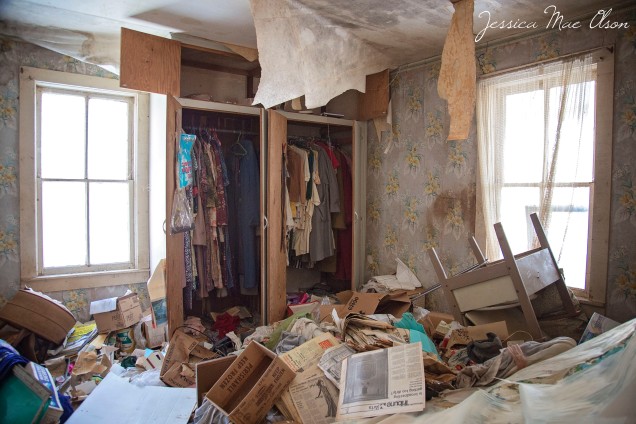
Wardrobes still filled with a mixture of vintage men’s and women’s clothing, old newspapers and children’s coloring books littering the floor, farming receipts and soy bean catalogs, old farming receipts and a pair of dusty glasses.

While I often find myself incredibly moved by the locations I encounter, there was something special about this family room. From the dark mahogany piano covered in dust and the faded Mozart music books to the old television set surrounded by trash and the image of a young child and Model T. This was one of the first houses I ever encountered with so much history left behind.


It wasn’t until recently that I decided to dig into the past of this little white farmhouse. What I uncovered was a typical american story. Married in 1880, German immigrants Louis and Paulena Roos made their home in rural Minnesota. Their son William, one of seven, would make his home in nearby Lester Prairie with wife Emma and carry on the farming tradition. A love for agriculture and farm equipment would further pass on to son Reuben, who would return to the family farm after serving his country in the Korean war.

After his death in 2014, an auction was held to sell off the collection of antique cars, tractors and farm equipment he had so obviously loved and cherished throughout his lifetime. With only a year of time passing between the auction and my own visit in 2015, there is no doubt that this house was starting to decay long before it was left vacant and open to the elements.

Recently purchased by a large corporation, this house will likely meet the cold metal of a bulldozer in the coming years, if not months and is certainly in the last moments of it’s life. While always hard to accept a family home such as this left to rot, it is even harder to imagine it being completely wiped out of existence. While doubtful that I will have the opportunity to see it again before it meets it’s inevitable fate, I am thankful for these precious images and a carefully preserved Polaroid in my china cabinet to remember it by.
While preparing for a trip to North Dakota last September, I found myself randomly browsing google for possible locations. While I spend more time perusing google aimlessly than I would like to admit, this time it certainly paid off. I came across an image of a dusty bookcase filled with old textbooks. Obviously, with my love of books, not finding this school was not an option. With many more hours and some hints from fellow explorers, I found myself making the six hour journey to Nome, North Dakota. While not exactly on the way to our final destination of Devils Lake, every extra minute was worth it.
The Nome school was opened in 1916 and was only in use until sometime in 1966. The image below was originally used as the cover of the school Annual and was taken sometime in the 1950’s. Nome saw it’s population peak just prior to this time with the 1940 census recording 277 residents.

Since then, Nome has seen a steady decrease in residents with current estimates almost below 60. It seems the residents have taken notice to the steady decline of their home as well. The first sign that greeted us upon entering Nome stated: “slow down, we are still here”. Even the school is failing to make it’s presence known as it is slowly suffocated by trees and shrubs. If you weren’t looking for it, it would be almost impossible to see this hidden gem from the main road.

After making our way through the brush and climbing over various kinds of debris, we found ourselves greeted by glass paneled double doors and a grand wood main staircase shrouded in darkness. Once we climbed higher, we were able to finally see the beautiful decay that is the Nome School.

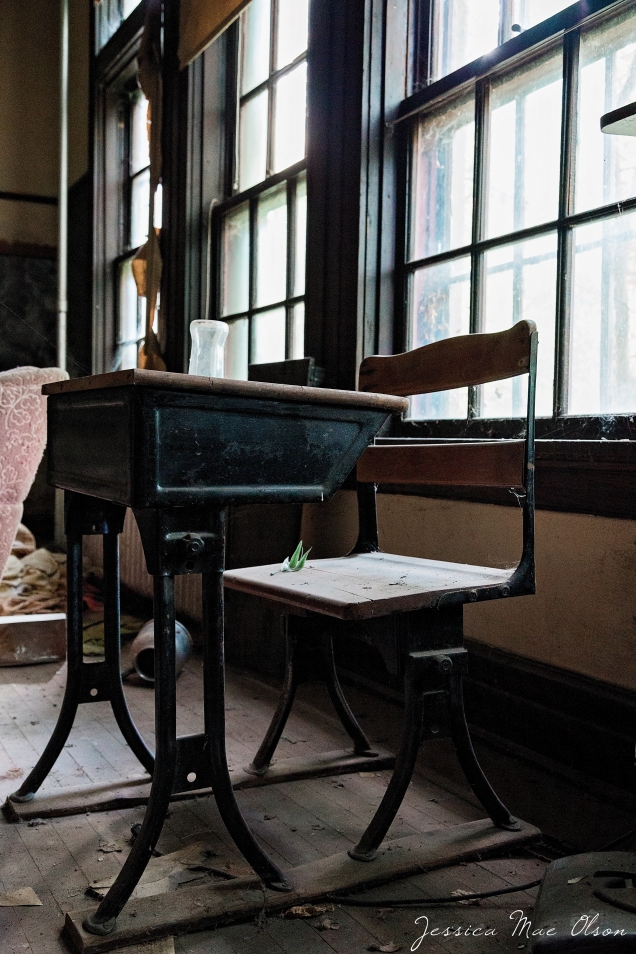
Everywhere you look, you are greeted with huge glass windows, carved wooden banisters and cabinets, antique cloth chairs and black metal desks, glass vases and porcelain figurines, dusty books and used suitcases, rotting world maps and faded chalkboards.



While I doubt I would ever be able to spend enough time capturing the beauty of this school, I know this is one place that I will always think about and wish I had been able to explore in more detail. I wouldn’t mind another look at all those old textbooks either…

Built in the 30’s, the original house was specifically designed by a wealthy widow for her disabled daughter. Unfortunately the daughter died long before she was ever able to set foot in the beautiful house overlooking the Red River. After spending many years in the the 20 room house alone, it was gifted to the Alexian Brothers to be used by the Catholic Church.

With the completion of extensive renovations, the first novice class of 14 individuals arrived. In order to become more self sustainable, the property was further expanded through the purchase of an additional 172 acres adjoining the property.
Right here, in the Wisconsin wilderness, people from all over studies and prepared themselves for a lifetime of service to others under the guidance of their superiors. Even after all their time and work, changes to the church and a desire for new forms of spiritual formation led the brothers to Chicago. The now 65 room mansion overlooking the river was put up for sale. With no sale in sight, negotiations began with an organization of Indians from Green Bay.
After this plan failed, the house was left in the hands of a caretaker and his family. In 1974, the family was awoken in the middle of the night and taken hostage by armed members of the Menominee Warrior Society, who claimed the land was rightly theirs. Failing to meet a true settlement, the house continued to change hands until it fell into disuse and eventually it became the unfortunate victim of arson. All that remains is the shell of a once grand mansion.

